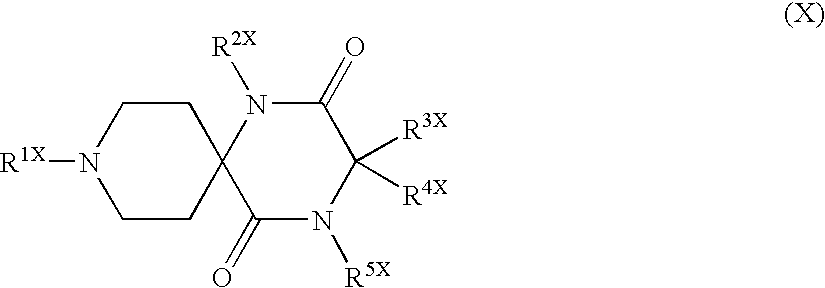Function Inhibitor of Effector Cell
a function inhibitor and effector cell technology, applied in the direction of biocide, immunodeficiency, drug composition, etc., can solve the problems of attenuation of effects, serious side effects, and recurrence of chronic rejection reactions, and achieve strong side effects
- Summary
- Abstract
- Description
- Claims
- Application Information
AI Technical Summary
Benefits of technology
Problems solved by technology
Method used
Image
Examples
example 1
Migration Test of Human CCR5 Expression Cell (hCCR5-Ba / F3 Cell)
(1-1) Establishment of Human CCR5 Expression Cell
Isolation of Human CCR5 Gene
[0292] Human placental cDNA was prepared using Marathon cDNA Amplification Kit (Clontech). PCR primers hCCR5XbaI-F1: 5′-AGCTAGTCTA GATCCGTTCC CCTACAAGAA ACTCTCC-3′ (SEQ ID NO:1) and hCCR5XbaI-R1: 5′-AGCTAGTCTA GAGTGCACAA CTCTGACTGG GTCACCA-3′ (SEQ ID NO:2) were designed based on the sequence of GenBank U54994.
[0293] Using the human placental cDNA as the template and using Ex Taq (Takara), PCR reaction (2 minutes at 95° C.→[30 seconds at 95° C., 45 seconds at 60° C., 1 minute at 72° C.]×35 times) was carried out. The thus amplified PCR product was subjected to 1% agarose gel electrophoresis and then purified using QIAquick Gel Extraction Kit (QIAGEN) and digested with a restriction enzyme XbaI. The thus digested fragment was ligated with an expression vector pEF-BOS-bsr using DNA Ligation Kit Ver. 2 (Takara) and transformed into Escherichia...
example 2
Cell Growth Test Of Human CD8-Positive Memory T Cell
(2-1) Cell Preparation
[0301] A heparinized blood sample was collected from a human, healthy volunteer, and peripheral blood mononuclear cell (PBMC) was isolated by a density gradient centrifugation. Specifically, a blood sample (33 ml) 2-fold diluted with physiological saline was overlaid on a medium for hemocyte separation use (10 ml) having a specific gravity of 1.077±0.001 g / ml contained in a centrifugation tube (LymphoPrep tube (Nycomed Pharma)) and centrifuged (3000×g, 10 minutes) at room temperature. The layer containing PBMC was recovered and washed twice with PBS to isolate PBMC.
Preparation of CD8-Positive T Cell
[0302] CD8-positive T cell was isolated from PBMC by a negative selection method using Human T Cell CD8 Subset Column Kit (R & D Systems, Inc). Specifically, the cells to be removed such as B cell, CD4-positive T cell, and monocyte were labeled with antibodies by adding an antibody cocktail (1 ml) (attached to...
example 3
Growth Test of Human CD4-Positive Th1 Differentiation Cell
(3-1) Preparation of Cells
[0314] A heparinized blood sample was collected from a human, healthy volunteer, and peripheral blood mononuclear cell (PBMC) was isolated by the density gradient centrifugation described in the above-described (2-1). CD4-positive T cell was isolated from PBMC by a negative selection method using Human T Cell CD4 Subset Column Kit (R & D Systems, Inc). Specifically, the cells to be removed such as B cell, CD8-positive T cell, monocyte and the like were labeled with antibodies by adding an antibody cocktail (1 ml) (attached to the kit) to PBMC (up to 2×108 cells) and incubating at room temperature for 15 minutes. The cells were washed twice with a column buffer (10 ml) (attached to the kit) and suspended in the column buffer (2 ml). The cell suspension was added to Human T Cell Subset Enrichment Column (attached to the kit) which had been equilibrated in advance using the column buffer (10 ml). By ...
PUM
| Property | Measurement | Unit |
|---|---|---|
| body weight | aaaaa | aaaaa |
| concentration | aaaaa | aaaaa |
| humidity | aaaaa | aaaaa |
Abstract
Description
Claims
Application Information
 Login to View More
Login to View More - R&D
- Intellectual Property
- Life Sciences
- Materials
- Tech Scout
- Unparalleled Data Quality
- Higher Quality Content
- 60% Fewer Hallucinations
Browse by: Latest US Patents, China's latest patents, Technical Efficacy Thesaurus, Application Domain, Technology Topic, Popular Technical Reports.
© 2025 PatSnap. All rights reserved.Legal|Privacy policy|Modern Slavery Act Transparency Statement|Sitemap|About US| Contact US: help@patsnap.com



